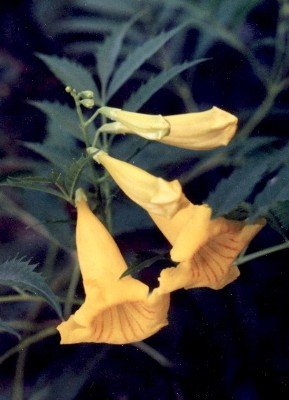Bells & Trumpets
by Valerie (April 27, 2002)
Two closely related plants with totally different habits, yellow bells and trumpet creeper are both endemic species commonly used in cultivation. Yellow bells (Tecoma stans), also called yellow trumpet flower, yellow elder, and yellow trumpetbush, is a small to medium sized shrub. It has attractive, notched foliage and produces blossoms throughout much of the summer. The plant freezes back to the ground during the winter, but sprouts midway through spring.  The first plant we obtained as a small nursery purchase, and it took two years before it flowered. It is also growing in shade and so doesn't flower profusely. The pods are long and slender, and the seeds, which are flat with wings, are very easy to germinate. Without much effort we've been able to start plants in a couple other places in the gardens. They do start slowly, though, taking a couple seasons before they begin to flower. The first plant we obtained as a small nursery purchase, and it took two years before it flowered. It is also growing in shade and so doesn't flower profusely. The pods are long and slender, and the seeds, which are flat with wings, are very easy to germinate. Without much effort we've been able to start plants in a couple other places in the gardens. They do start slowly, though, taking a couple seasons before they begin to flower.
Yellow bells' aggressive cousin, trumpet creeper (Campsis radicans), is among the most hardy and easily grown vines I've seen. We started with one large seed pod and it seems that just about every seed germinated. After removing what seemed like hundreds of seedlings, we still had about a dozen that we allowed to grow. These vines are deciduous but the woody stems do not freeze back at all. In the spring, the plants start growing right where they left off the previous season. I've heard estimates of their height at 30 to 60 feet, but the most memorable description was that the vines grow 10 feet taller than any surrounding structure or vegetation. The young plants establish quickly, with a deep, thick root, and are nearly impossible to eradicate after one year. They spread by tough underground rhizomes as well as by seed. The vines seem to need no extra water and never look wilted or stressed, even in the hottest part of summer.
Other names for this plant are bignonia, trumpet vine, foxglove vine, cow-itch vine, and cow vine. The term cow-itch is derived from a reaction some people have to the foliage. I've never noticed anything after pruning the branches (and I've pruned it a lot), but it can cause a red rash and slight itching after making contact. |
 Our plants are growing along a fence, and into the overhanging live oak tree and, because of the shade, they produce far more foliage than flowers. The leaves are dark green and glossy. The vines do bloom, however, and the hummingbirds love the large orange blooms. The flowers are usually in groups of no more than three and, besides attracting birds, other insects seem to relish them, including ants which swarm over the blossoms.
Our plants are growing along a fence, and into the overhanging live oak tree and, because of the shade, they produce far more foliage than flowers. The leaves are dark green and glossy. The vines do bloom, however, and the hummingbirds love the large orange blooms. The flowers are usually in groups of no more than three and, besides attracting birds, other insects seem to relish them, including ants which swarm over the blossoms.